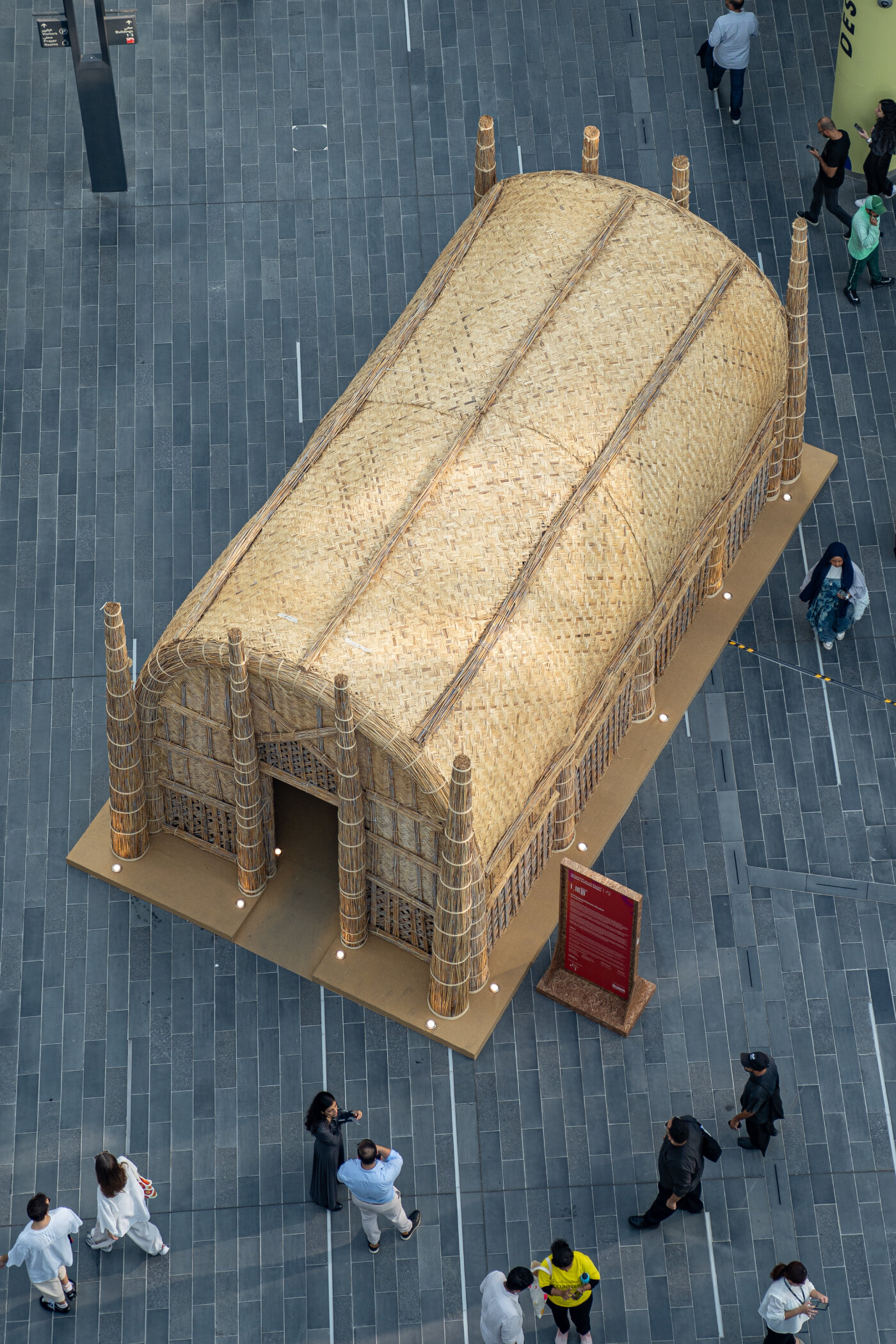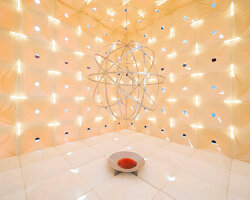dubai design week imagines architecture of the future
In its tenth edition, this year’s Dubai Design Week invited designers across the Arab world to reflect on how vernacular expressions can inform sustainable solutions with its Abwab commission. Ola Saad Znad’s Abwab pavilion, A Present/Absent Mudhif, looks to the ancient building techniques of the Marsh Arabs in southern Iraq to reimagine the mudhif — a traditional guesthouse built entirely from reeds and mud. In quiet contrast to the design district’s glass structures that tower over it, the pavilion is shaped almost entirely from reeds, woven into mats that create a breathable facade, supporting structural elements, and small furnishings within. The architect tells designboom that her choice to spotlight this centuries-old architectural heritage stems first from her pride in her Iraqi roots, as well as an urgent need to address its fragility as it faces mounting challenges of environmental degradation. ‘Climate change and water depletion pose existential threats to the Iraqi marshlands and the Marsh Arab communities,’ she shares. ‘Rising temperatures, upstream dams, have shrunk the marshes, endangering livelihoods and the reed craftsmanship essential to mudhifs.’
The work reflects both a concern for the survival of a culture as well as a celebration of its legacy. As Saad Znad explains, ‘The pavilion is a poetic reflection on both presence and absence: while it celebrates the craftsmanship and resilience of this heritage, it mourns the potential loss of these traditions.’ Created in close collaboration with indigenous artisans, A Present/Absent Mudhif embodies the versatility and sustainability of reed that has sustained the Marsh Arabs for centuries — an abundantly available material in the region with remarkable strength, flexibility, and insulation properties. Parallel to the selected Abwab theme, Architecture of the Future, the architect also taps into the potential applications of these historic crafts in contemporary contexts, suggesting possibilities for urban furniture, shading structures, and climate-responsive architecture. We spoke with Ola Saad Znad to learn more about her work and her philosophy of architecture as a tool for inclusivity, sustainability, and dialogue. Read our full interview below.

all images by Social Studio Middle East unless stated otherwise
interview with ola saad znad on a present/absent mudhif
designboom (DB): Please introduce us to your A Present/Absent Mudhif pavilion at Dubai Design Week.
Ola Saad Znad (OSZ): A Present/Absent Mudhif is a multisensory installation that revives the ancient tradition of the mudhif — a guesthouse crafted entirely of reeds, and a form deeply rooted in the cultural identity of the Marsh Arabs in southern Iraq. The pavilion is a poetic reflection on both presence and absence: while it celebrates the craftsmanship and resilience of this heritage, it mourns the potential loss of these traditions due to the growing challenges of water scarcity and climate change. The very materials and techniques that define the mudhif are at risk of disappearing as the marshlands — once a cradle of civilization — face environmental degradation.
In response to this year’s Abwab theme, Architecture of the Future, the pavilion questions how we can safeguard such fragile yet significant cultural practices for future generations. We integrate traditional knowledge with contemporary design thinking to highlight the urgency of preserving these crafts while exploring their evolution in a rapidly changing world.

A Present/Absent Mudhif at Dubai Design Week
DB: What drew you to explore the culture of the Marsh Arabs and their use of reed as a building material?
OSZ: My connection to the culture of the Marsh Arabs stems from my pride in my Iraqi roots and my fascination with the relationship between architecture, identity, and memory. The Marsh Arabs’ way of life is a powerful testament to the resilience of human ingenuity in harmony with nature. Their use of reeds as a building material is very sustainable but also deeply symbolic as it represents an intimate dialogue between people and their environment. The architectural traditions of the Marsh Arabs, particularly the mudhif, encapsulate centuries of cultural knowledge that could be lost if their way of life fades.

the Abwab commission reflects on how vernacular expressions can inform sustainable solutions
DB: Can you explain more about how these climate challenges are impacting the land and its communities? How does your pavilion address this?
OSZ: Climate change and water depletion pose existential threats to the Iraqi marshlands and the Marsh Arab communities. Rising temperatures and upstream dams have shrunk the marshes, endangering livelihoods and the reed craftsmanship essential to mudhifs. A Present/Absent Mudhif reflects my three years of research into these crises.
By highlighting their use of reeds and architectural practices, I aim to celebrate their ingenuity while raising awareness about the urgent need to preserve these traditions and the environment that sustains them. This exploration is as much about honoring a unique culture as it is about advocating for its survival.

Ola Saad Znad looks to the ancient building techniques of the Marsh Arabs in southern Iraq
DB: Can you share a little about the collaborations that brought the pavilion to life?
OSZ: The most exciting part of the journey was collaborating with indigenous artisans, learning their reed weaving techniques, and then teaching these skills to other workers who weren’t experts in the craft. This process was incredibly fulfilling. The joy of working hands-on and seeing how people engaged with the craft made the whole experience so meaningful. In doing this, the pavilion also became a bridge, connecting the Marsh Arabs’ heritage with a global audience.
DB: You celebrate reed here as a sustainable building material with great heritage value. What are its core properties that you wish to harness for building?
OSZ: Reed is a remarkable building material and its core properties make it both sustainable and versatile. Its lightweight nature makes it easy to work with, while its strength and flexibility allow it to be woven into intricate, resilient structures like the mudhif. It is also highly renewable and eco-friendly — it grows quickly and abundantly in the marshlands, requiring minimal energy to harvest and process.
What I find most valuable about reed is its natural insulation properties. It offers excellent thermal regulation, keeping spaces cool in the heat and warm in cooler weather. It’s also water-resistant, which is essential for building in flood-prone areas like the marshlands. By harnessing these properties, we can create climate-responsive designs that are not only functional but also respectful of the environment, just as the Marsh Arabs have done for centuries.

reimagining the mudhif — a traditional guesthouse
DB: Symbolically and physically, how did you hope visitors would interpret and experience the space?
OSZ: I envisioned the mudhif as a sanctuary — a space that offers both physical and emotional refuge, much like the original structures did for the Marsh Arabs. The pavilion serves as a bridge between worlds, connecting the cultural heritage of the marshlands with contemporary urban life. I hoped visitors would interpret the space as a place of dialogue between cultures and between the past and present. The experience was meant to evoke a sense of welcome and comfort.
By immersing in the multisensory elements of the pavilion — the textures, sounds, and visuals — visitors could experience the warmth and intimacy of the mudhif, while also confronting its fragility in the face of environmental challenges. Ultimately, I wanted the space to spark a deeper conversation about cultural preservation and resilience, sustainability, and our shared responsibility to protect both heritage and the environment. The pavilion is a call to action.

built entirely from reeds and mud
DB: You’ve mentioned previously that you’re exploring reed’s potential for crafting urban furniture and shading structures. How do you see this material being adapted for contemporary contexts, climates, and environments?
OSZ: Reed has great potential for urban furniture and shading structures in contemporary settings due to its versatility, accessibility, and sustainability. Its lightweight yet strong nature makes it ideal for creating durable, portable pieces like benches and pergolas. Reed’s flexibility also allows designers to easily mold and shape it into various forms, making it adaptable to different design needs. With natural insulation and water resistance, it’s perfect for outdoor use in hot climates, offering shade and cooling. By reinterpreting traditional techniques, we can design eco-friendly, sustainable furniture that connects urban spaces with nature while reducing heat island effects.

the pavilion reflects both a concern for survival of a cultural as well as a celebration of its legacy
DB: How do you hope your work can continue sparking global/regional conversations about heritage, sustainability, and architecture — and particularly their relationship with nature?
OSZ: I hope my work continues to spark global and regional conversations about the critical relationship between heritage, sustainability, and architecture, particularly in how these elements connect with nature. By focusing on materials like reeds and traditions such as the mudhif, I want to encourage a broader appreciation for the wisdom embedded in indigenous practices and highlight the importance of sustainability in modern design.
As an architect, artist, and urban designer, I will continue to explore how architecture can serve as a tool for social change, inclusivity, and environmental responsibility. I am also particularly passionate about researching how cities can embrace diversity and engage communities, bringing these discussions into both research and public spheres to inspire action toward sustainable and inclusive urban futures.

‘Climate change and water depletion pose existential threats to the Iraqi marshlands and the Marsh Arab communities’

created in collaboration with indigenous craftsmen

‘reed’s lightweight yet strong nature makes it ideal for creating durable, portable pieces like benches and pergolas’

reed is lightweight, durable, flexible, water-resistant, and easy to harvest


woven in various techniques by indigenous artisans

‘The pavilion serves as a bridge, connecting the cultural heritage of the marshlands with contemporary urban life’
project info:
name: A Present/Absent Mudhif
architect: Ola Saad Znad | @olaznad
program: Dubai Design Week | @dubaidesignweek
dates: November 5th — 10th, 2024
location: Dubai Design District, UAE



























